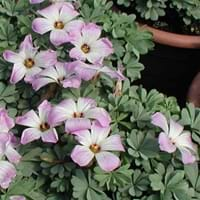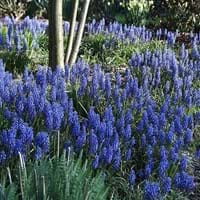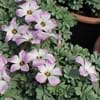Life Span
Perennial
Perennial
Type
Bulb or Corm or Tuber
Bulb or Corm or Tuber
Origin
Argentina, Chile
Mediterranean, Southeastern Asia
Types
Not available
Not available
Habitat
Shaded sites, Woodlands
Fields, Open areas, Terrestrial
USDA Hardiness Zone
7-9
Not Available
AHS Heat Zone
10-3
Not Available
Habit
Clump-Forming
Clump-Forming
Minimum Height
Not Available
Minimum Width
Not Available
Flower Color
White, Fuchsia, Rose, Violet
White, Yellow, Blue, Purple, Pink, Olive, Blue Violet
Flower Color Modifier
Bicolor
Bicolor
Fruit Color
Not Available
Brown, Black
Leaf Color in Spring
Light Green, Gray Green
Not Available
Leaf Color in Summer
Light Green
Light Green
Leaf Color in Fall
Several shades of Green
Several shades of Green
Leaf Color in Winter
Light Green
Light Green
Leaf Shape
Heart-shaped
Narrow
Plant Season
Spring, Summer, Fall
Not Available
Sunlight
Full Sun, Partial Sun, Partial shade
Full Sun, Partial Sun
Growth Rate
Medium
Not Available
Type of Soil
Clay, Loam, Sand
Not Available
The pH of Soil
Neutral
Not Available
Soil Drainage
Well drained
Well drained
Bloom Time
Late Spring, Early Summer, Summer, Late Summer, Early Fall, Fall
Not Available
Tolerances
Drought
Drought
Where to Plant?
Ground, Pot
Container, Ground, Pot
How to Plant?
Divison, Seedlings
From bulbs, From Rhizomes, Seedlings
Plant Maintenance
Medium
Medium
Watering Requirements
Water in the early morning hours
Get enough water whenever the soil is dry, Keep the ground moist but not water-logged, Keep the Soil well drained
In Summer
Lots of watering
Lots of watering
In Spring
Moderate
Moderate
In Winter
Average Water
Average Water
Soil pH
Neutral
Not Available
Soil Type
Clay, Loam, Sand
Not Available
Soil Drainage Capacity
Well drained
Well drained
Sun Exposure
Full Sun, Partial Sun, Partial shade
Full Sun, Partial Sun
Pruning
Remove damaged leaves, Remove dead branches, Remove dead leaves
Remove damaged leaves, Remove dead branches, Remove dead leaves
Fertilizers
All-Purpose Liquid Fertilizer
All-Purpose Liquid Fertilizer
Pests and Diseases
Red blotch
Armored scales, Crown rot, Slugs
Plant Tolerance
Drought
Drought
Flower Petal Number
Single
Single
Foliage Texture
Medium
Medium
Foliage Sheen
Matte
Glossy
Attracts
Insects
Bees, Butterflies
Allergy
Asthma, Depression
Diarrhea, Itchiness, Skin irritation, Stomach pain, Vomiting
Aesthetic Uses
Cottage Garden, Formal Garden, Ground Cover, Showy Purposes
Cottage Garden, Landscape Designing
Beauty Benefits
Not Available
Not Available
Environmental Uses
Air purification
Air purification
Medicinal Uses
Not Available
Diuretic, Stimulates new cell growth
Part of Plant Used
Flowers
Buds, Flowers
Other Uses
Basketary
Traditional medicine, Used for fragrance
Used As Indoor Plant
No
Yes
Used As Outdoor Plant
Yes
Yes
Garden Design
Alpine, Container, Houseplant, Mixed Border, Rock Garden / Wall
Container, Cutflower, Mixed Border, Rock Garden / Wall
Botanical Name
OXALIS adenophylla
MUSCARI
Common Name
Chilean Wood Sorrel, Pink Buttercups, Pink Carpet Oxalis, Silver Shamrock
Grape Hyacinth
In Hindi
Chilean Wood Sorrel
अंगूर जलकुंभी
In German
Chilean Wood Sorrel
Traubenhyazinthen
In French
Chilean Wood Sorrel
Muscari
In Spanish
Chilean Wood Sorrel
Muscari
In Greek
Chilean Wood Sorrel
grape hyacinth
In Portuguese
Chilean Wood Sorrel
Muscari
In Polish
Chilean Wood Sorrel
Szafirek
In Latin
Chilean Wood Sorrel
Muscari
Phylum
Magnoliophyta
Tracheophyta
Class
Magnoliopsida
Magnoliopsida
Order
Oxalidales
Asparagales
Family
Oxalidaceae
Asparagaceae
Clade
Angiosperms, Eudicots, Rosids
Angiosperms, Monocots
Tribe
Not Available
Not Available
Subfamily
Not Available
Scilloideae
Properties of Chilean Wood Sorrel and Grape Hyacinth
Wondering what are the properties of Chilean Wood Sorrel and Grape Hyacinth? We provide you with everything About Chilean Wood Sorrel and Grape Hyacinth. Chilean Wood Sorrel doesn't have thorns and Grape Hyacinth doesn't have thorns. Also Chilean Wood Sorrel does not have fragrant flowers. Chilean Wood Sorrel has allergic reactions like Asthma and Depression and Grape Hyacinth has allergic reactions like Asthma and Depression. Compare all the properties and characteristics of these two plants. Find out which of these plant can be used as indoor plant. If you are interested to decorate your house and garden, find out aesthetic uses, compare them and select the plant which will beautify your surrounding. Along with beautification, try comparing medicinal and edible uses of Chilean Wood Sorrel and Grape Hyacinth and you can choose the plant having best and most benefits.
Season and Care of Chilean Wood Sorrel and Grape Hyacinth
Season and care of Chilean Wood Sorrel and Grape Hyacinth is important to know. While considering everything about Chilean Wood Sorrel and Grape Hyacinth Care, growing season is an essential factor. Chilean Wood Sorrel season is Spring, Summer and Fall and Grape Hyacinth season is Spring, Summer and Fall. The type of soil for Chilean Wood Sorrel is Clay, Loam, Sand and for Grape Hyacinth is Not Available while the PH of soil for Chilean Wood Sorrel is Neutral and for Grape Hyacinth is Not Available.
Chilean Wood Sorrel and Grape Hyacinth Physical Information
Chilean Wood Sorrel and Grape Hyacinth physical information is very important for comparison. Chilean Wood Sorrel height is 10.20 cm and width 15.20 cm whereas Grape Hyacinth height is Not Available and width Not Available. The color specification of Chilean Wood Sorrel and Grape Hyacinth are as follows:
Chilean Wood Sorrel flower color: White, Fuchsia, Rose and Violet
Chilean Wood Sorrel leaf color: Light Green and Gray Green
Grape Hyacinth flower color: White, Yellow, Blue, Purple, Pink, Olive and Blue Violet
- Grape Hyacinth leaf color: Not Available
Care of Chilean Wood Sorrel and Grape Hyacinth
Care of Chilean Wood Sorrel and Grape Hyacinth include pruning, fertilizers, watering etc. Chilean Wood Sorrel pruning is done Remove damaged leaves, Remove dead branches and Remove dead leaves and Grape Hyacinth pruning is done Remove damaged leaves, Remove dead branches and Remove dead leaves. In summer Chilean Wood Sorrel needs Lots of watering and in winter, it needs Average Water. Whereas, in summer Grape Hyacinth needs Lots of watering and in winter, it needs Average Water.





